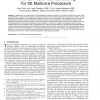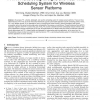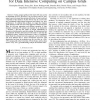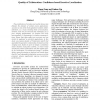TPDS
2010
13 years 9 months ago
2010
Abstract—A rising horizon in chip fabrication is the 3D integration technology. It stacks two or more dies vertically with a dense, highspeed interface to increase the device den...
TPDS
2010
13 years 9 months ago
2010
—We consider an end-to-end approach of inferring probabilistic data-forwarding failures in an externally managed overlay network, where overlay nodes are independently operated b...
TPDS
2010
13 years 9 months ago
2010
—One widely used mechanism for representing membership of a set of items is the simple space-efficient randomized data structure known as Bloom filters. Yet, Bloom filters are no...
TPDS
2010
13 years 9 months ago
2010
—Thread-level parallelism (TLP) has been extensively studied in order to overcome the limitations of exploiting instruction-level parallelism (ILP) on high-performance superscala...
TPDS
2010
13 years 9 months ago
2010
—We propose FIT, a flexible, lightweight, and real-time scheduling system for wireless sensor platforms. There are three salient features of FIT. First, its two-tier hierarchical...
TPDS
2010
13 years 9 months ago
2010
s: An Abstraction for Data Intensive Computing on Campus Grids Christopher Moretti, Hoang Bui, Karen Hollingsworth, Brandon Rich, Patrick Flynn, and Douglas Thain Department of Com...
TPDS
2010
13 years 9 months ago
2010
—A recursive multi-hop area hierarchy has a number of applications in wireless sensor networks, the most common being scalable point-to-point routing, so-called hierarchical rout...
TPDS
2010
13 years 9 months ago
2010
This paper studies the problem of realizing a common software clock among a large set of nodes without an external time reference (i.e., internal clock synchronization), any centr...
TPDS
2010
13 years 9 months ago
2010
The proliferation of wireless and mobile devices has fostered the demand of context aware applications. Location is one of the most significant contexts. Multilateration, as a bas...
TPDS
2010
13 years 9 months ago
2010
—This paper derives simple, yet fundamental formulas to describe the interplay between parallelism of an application, program performance, and energy consumption. Given the ratio...




